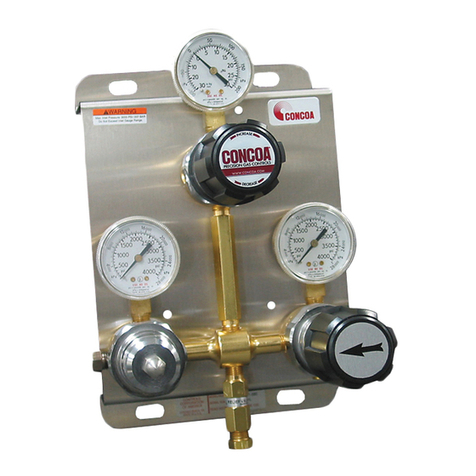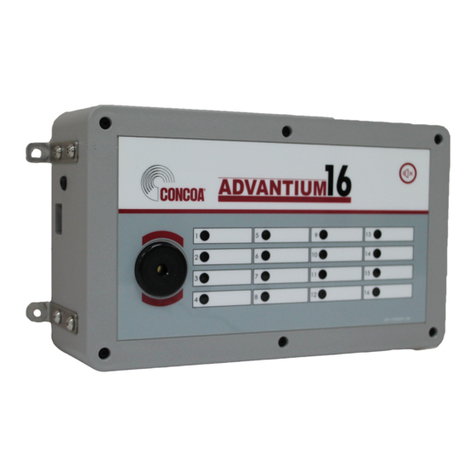
4
Theautoswitch monitoringsystem isusedwhenstatusmonitoring ofthe inletpressureis needed. Thesystemcanbe
configured with multiple remote alarms. This is particularly helpful because it provides status notification to mul-
tipleusers. Thesystemmayalsobeconfigured with telephone dialers that will call the userandalert them to the low
status of up t o four autoswitches.
Connections to most of the system components are made to terminal blocks. A small flat-blade screwdriver is
required to tighten the terminal block connections on the remote alarm. Connections to the autoswitch are made
using a connector supplied by CONCOA. A soldering iron and solder are required to wire this connector. The
customersuppliesallcabling that connects the system components. Formoreinformation on installation, please see
the section that applies to the particular unit.
When using your autoswitch monitoring system, basic safety precautions must be followed to reduce the risk of fire,
electrical shock, and injury.
a. Read and understand all instructions. Follow all warnings and instructions marked on the product.
b. Install the remote alarms, dialers, or secondary remote alarms where they will not be subjected to rain or
condensation. Discontinue use of these device if it is suspected that liquids have penetrated the case; have
the device serviced.
c. Install the remote alarm and secondary remote alarm in locations where the temperature varies between 0°
and 140°F. The autoswitch may be installed in locations where the temperature varies between –40° and
140°F (-40 to 60°C).
d. Do not install the remote alarm, secondary remote alarm, or dialer in hazardous locations.
e. The nameplate on the side of the autoswitch gives instructions on installing the autoswitch in a hazardous
location.
f. Handle theremotealarm,dialer,or secondary remotealarm with care. Ifdamaged ordropped,suspenduse
immediately.
g. Operate the 529 5298 and 529 5300 remote alarm with the type of power source indicated on the remote
alarm. If you are not sure of your power source, contact your dealer or local power company.
h. Avoidoverloadingwalloutletsandextensions cords;thismayresultinelectrical shockorfire. The120VAC
remote alarm input is rated to 0.4 Amps; the 220 VAC remote alarm input is rated to 0.4 Amps.
i. Never push objects of any kind inside the case as the objects may touch dangerous voltage points or may
short parts that could result in the risk of electrical shock or fire.
j. Protect the power cord or any other connecting cables, and do not use if any wires are frayed, damaged, or
loose.
Autoswitch
The autoswitch provides visual alarm status only. The left/right banks both have alarm LED’s. The LED’s will
illuminate when the right/left bank pressure is below the alarm set point on the switchover inlet gauge. The LED’s
will turn off when the left/right bank pressure is above the alarm set point. The autoswitch power LED will be lit
when the remote alarm is connected, and the remote alarm switch is on. If the power LED is not on, the electronics
are not functioning.
Slide the red tab seen on the autoswitch inlet gauge to adjust the alarm set point. Note that CONCOA does not
recommend lowering the factory set point of the alarm system. When adjustments are made, check the function of
the system. Pressurize the system and shut off the inlet pressure to both sides. Allow the inlet pressure on the right
DESCRIPTION OF PRODUCT
GENERAL SAFETY PRACTICES
INTENDED USE OF PRODUCT

































